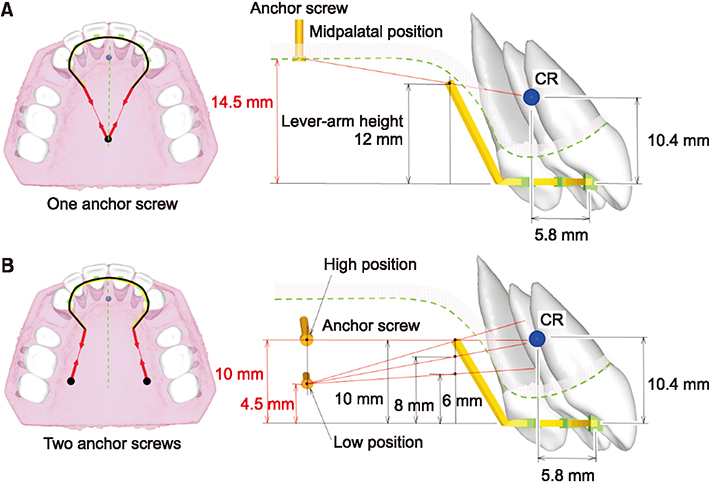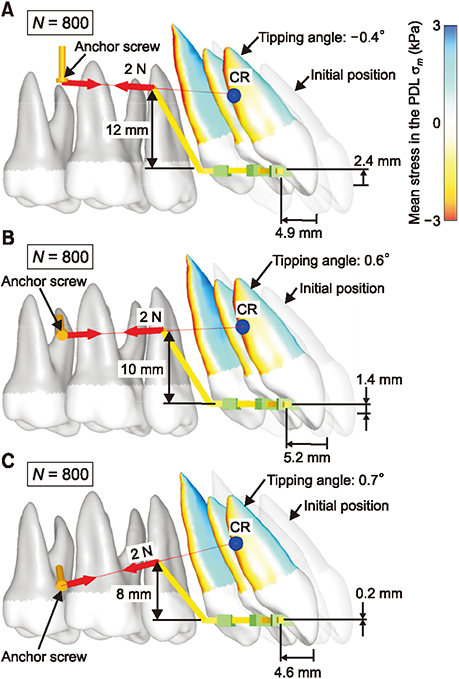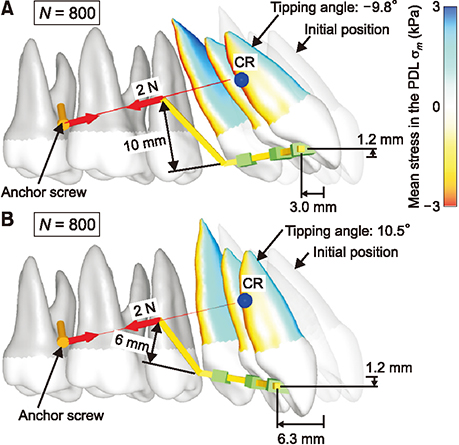Korean J Orthod.
2019 May;49(3):188-193. 10.4041/kjod.2019.49.3.188.
Palatal en-masse retraction of segmented maxillary anterior teeth: A finite element study
- Affiliations
-
- 1Postgraduate Orthodontic Program, Arizona School of Dentistry & Oral Health, A.T. Still University, Mesa, AZ, USA. jongmoon@wku.ac.kr
- 2Graduate School of Dentistry, Kyung Hee University, Seoul, Korea.
- 3Department of Orthodontics, The Catholic University of Korea, Seoul St. Mary's Hospital, Seoul, Korea.
- 4Department of Mechanical Engineering, Nagoya Institute of Technology, Nagoya, Japan.
- 5Private Practice, Jinju, Korea.
- 6Department of Orthodontics, School of Dentistry, Wonkwang University, Iksan, Korea.
- 7Wonkwang Dental Research Institute, School of Dentistry, Wonkwang University, Iksan, Korea.
- KMID: 2450228
- DOI: http://doi.org/10.4041/kjod.2019.49.3.188
Abstract
OBJECTIVE
The aim of this finite element study was to clarify the mechanics of tooth movement in palatal en-masse retraction of segmented maxillary anterior teeth by using anchor screws and lever arms.
METHODS
A three-dimensional finite element method was used to simulate overall orthodontic tooth movements. The line of action of the force was varied by changing both the lever arm height and anchor screw position.
RESULTS
When the line of action of the force passed through the center of resistance (CR), the anterior teeth showed translation. However, when the line of action was not perpendicular to the long axis of the anterior teeth, the anterior teeth moved bodily with an unexpected intrusion even though the force was transmitted horizontally. To move the anterior teeth bodily without intrusion and extrusion, a downward force passing through the CR was necessary. When the line of action of the force passed apical to the CR, the anterior teeth tipped counterclockwise during retraction, and when the line of action of the force passed coronal to the CR, the anterior teeth tipped clockwise during retraction.
CONCLUSIONS
The movement pattern of the anterior teeth changed depending on the combination of lever arm height and anchor screw position. However, this pattern may be unpredictable in clinical settings because the movement direction is not always equal to the force direction.
MeSH Terms
Figure
Reference
-
1. Gjessing P. Controlled retraction of maxillary incisors. Am J Orthod Dentofacial Orthop. 1992; 101:120–131.
Article2. Park YC, Choy K, Lee JS, Kim TK. Lever-arm mechanics in lingual orthodontics. J Clin Orthod. 2000; 34:601–605.3. Chung KR, Oh MY, Ko SJ. Corticotomy-assisted orthodontics. J Clin Orthod. 2001; 35:331–339.4. Hong RK, Heo JM, Ha YK. Lever-arm and mini-implant system for anterior torque control during retraction in lingual orthodontic treatment. Angle Orthod. 2005; 75:129–141.5. Kim SH, Park YG, Chung K. Severe Class II anterior deep bite malocclusion treated with a C-lingual retractor. Angle Orthod. 2004; 74:280–285.6. Park YC, Chu JH, Choi YJ, Choi NC. Extraction space closure with vacuum-formed splints and miniscrew anchorage. J Clin Orthod. 2005; 39:76–79.7. Chung KR, Cho JH, Kim SH, Kook YA, Cozzani M. Unusual extraction treatment in Class II division 1 using C-orthodontic mini-implants. Angle Orthod. 2007; 77:155–166.
Article8. Park YC, Choi YJ, Choi NC, Lee JS. Esthetic segmental retraction of maxillary anterior teeth with a palatal appliance and orthodontic mini-implants. Am J Orthod Dentofacial Orthop. 2007; 131:537–544.
Article9. Chung KR, Kook YA, Kim SH, Mo SS, Jung JA. Class II malocclusion treated by combining a lingual retractor and a palatal plate. Am J Orthod Dentofacial Orthop. 2008; 133:112–123.
Article10. Jang HJ, Roh WJ, Joo BH, Park KH, Kim SJ, Park YG. Locating the center of resistance of maxillary anterior teeth retracted by Double J Retractor with palatal miniscrews. Angle Orthod. 2010; 80:1023–1028.
Article11. Lee EH, Yu HS, Lee KJ, Park YC. Three dimensional finite element analysis of continuous and segmented arches with use of orthodontic miniscrews. Korean J Orthod. 2011; 41:237–254.
Article12. Park JH, Tai K, Takagi M, Miyajima K, Kojima Y, Joo BH. Esthetic orthodontic treatment with a double J retractor and temporary anchorage devices. Am J Orthod Dentofacial Orthop. 2012; 141:796–805.
Article13. Mo SS, Kim SH, Sung SJ, Chung KR, Chun YS, Kook YA, et al. Torque control during lingual anterior retraction without posterior appliances. Korean J Orthod. 2013; 43:3–14.
Article14. Osipenko MA, Nyashin NY, Nyashin YI. Center of resistance and center of rotation of a tooth: the definitions, conditions of existence, properties. Russ J Biomech. 1999; 1:5–15.15. Kojima Y, Kawamura J, Fukui H. Finite element analysis of the effect of force directions on tooth movement in extraction space closure with miniscrew sliding mechanics. Am J Orthod Dentofacial Orthop. 2012; 142:501–508.
Article16. Kojima Y, Fukui H. A finite element simulation of initial movement, orthodontic movement, and the centre of resistance of the maxillary teeth connected with an archwire. Eur J Orthod. 2014; 36:255–261.
Article17. Kojima Y, Fukui H. Numerical simulations of canine retraction with T-loop springs based on the updated moment-to-force ratio. Eur J Orthod. 2012; 34:10–18.
Article18. Kim MJ, Park JH, Kojima Y, Tai K, Chae JM. A finite element analysis of the optimal bending angles in a running loop for mesial translation of a mandibular molar using indirect skeletal anchorage. Orthod Craniofac Res. 2018; 21:63–70.
Article
- Full Text Links
- Actions
-
Cited
- CITED
-
- Close
- Share
- Similar articles
-
- Finite element analysis of the effects of different archwire forms and power arm positions on maxillary incisors in en masse retraction using fixed lingual orthodontic appliances
- Three dimensional finite element analysis of the phenomenon during distal en masse movement of the maxillary dentition
- Factors influencing the axes of anterior teeth during SWA en masse sliding retraction with orthodontic mini-implant anchorage: a finite element study
- Force changes associated with differential activation of en-masse retraction and/or intrusion with clear aligners
- Three dimensional finite element analysis of continuous and segmented arches with use of orthodontic miniscrews





